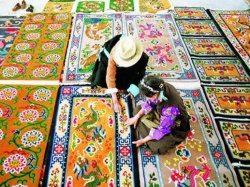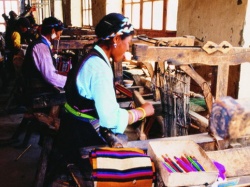Tibetan kaidian
IN Tibetan houses, people use cushions instead of chairs or stools. The cushion, called pudian in Tibetan, is 30 centimeters in height, 50 cm. wide and 70 cm. long, and is stuffed with soft hay or highland barley straw, which is then covered with canvas or hides. To keep warm and keep out the damp, people put two or three cushion together on the floor to use as chairs or beds. On the cushions, people place beautiful kardians, which are similar to carpets, but smaller in size, generally no larger than 2 square meters. The Tibetan women, with their adept hands, weave a variety of patterns, combining cotton thread with knitting wool. Their kardians range from mural paintings in ancient temples, flowers, bids and beasts, to landscapes, or even the Potala Palace, and the Himalayas. The Tibetan kardian is brightly colored because people dye the knitting wool not only with industrial dyes, but also with wild pants, ores, and the colored clay found in Tibet, to turn out as many as 36 different colors.
The kardians produced in Jiangzi County, Xigaze, are the most famous in the region. They have a history of over 600 years, and were introduced to Jiangzi County from Gangba County. They then spread to other places in Tibet and became one of the necessities in people's daily lives. Having heard that the director of the Jiangzi Kardian Factory is a woman, I headed there when passing Jiangzi. But, to my dismay, I failed to have an interview with her. It is a custom in Jiangzi that after the busy spring plughing season, the people celebrate their annual "dama" festival by holding horse races, yak races and archery contests. Before the festival the Baiju Temple in Jiangzi performs all sorts of Buddhist's activities, such as "the sorcerer's dance in a trance" and "airing the large picture of Buddha". People form all over go to watch the activities, as do the workers from the Jiangzi kardian Factory.
Later I went to Shannan. This is the home of the Naidong Kardian Factory a quite well-known factory in Tibet. The director, Dejiquzhen,38 and vice director, Cizenqiongda, 34, are sisters. When I went to interview them, they were busy checking on the quality of carpets. "These are carpets are for an American company. We have a contract to interview them, they were busy checking on the quality of carpets. "These are carpets are for an American contract to supply 5,000 square meters of carpets. Because this batch is urgently wanted, we've temporarily had to stop kardian productions."
Dejiquzhen can understand and speak a few sentences in Chinese, so she showed me around the factory. The factory building is not very big, but very clean. "In 1989, the autonomous region's government granted us a 500,000 yuan loan." Dejiquzhen said "and the following year, our output value reached 210,000 yuan." When I remarked on the fact that most workers who were weaving carpets or twisting wool were women, Dejiquzhen told me: "Most were farmers before they came to the factory, and had never tried weaving kardians before. It takes three years to train a skilled worker, but we've already trained more than 150."
As we entered the factory's meeting room Dejiquzhen drew back the curtain on one wall to expose many multicolored kardians which covered the entire wall. They were just a few of the sample products made by the factory. On another well were various certificates of merit, and silk award banners issued by the autonomous Region's Government, the Ministry of Light Industry, and the State Nationalities Affairs Commission.
I inquired about Dejiquzhen's weaving experiences. She told me: "My father was a native of Jiangzi and was good at weaving kardians. To make a living, one year, he came to Shannan from Jiangzi to weave kardians for a manor owner. He then married and settled down in Shannan. My younger sister and I learned how to twist thread from our mother at a very young age. We then learned from our father how to weave kardians.
"In 1974, Father borrowed 500 yuan and rented a two-room house to set up this factory. The kardians we produced won an award at a regional level appraisal of handmade products. But due to weak management and impeded sales relations, the business did not thrive.
"Before his death, Father told my sister and I that, if we couldn't manage the factory any longer, we could return home to farm. When he passed away, we became the heads of the factory and decided to try. We practiced quota management, designed new kardian patterns and sent salesmen to other parts of the country. Unexpectedly, our business began to improve. Now products not only sell well in Tibetan markets, but also are exported to Germany, Nepal and the United States."
Talking about the future of the factory, Dejiquzhen said: "The most urgent thing at present is to raise our factory's management level. A modernized management needs knowledge. But I had no chance to go to school when I was young. Now, I often feel that my ability falls short of my wishes. My sister is better than I because she has had some schooling."
Dejiquzhen is quite a frank Tibetan woman. She told me that her elder son was studying at a high school in Changzhou, Jiangsu Province, and her second son had passed the entrance examination to a high school in another city. But because she hated to part with him, she decided not to let him go. Last year, she and her husband went to see their son in Changzhou, and saw that he had grown taller and become more sensible. She now regrets that she had not let her second son study in the city. When I returned to Lhasa fr om Shannan, it was a Sunday. I walked to the Lhasa river where I saw many people washing kardians in the river. The flowing water washed the kardians just like a huge washing machine. And clean kardians were laid out all along the long river bank to dry, like a kardian exhibition. I was lucky to have the opportunity to see such a beautiful display. While waiting for their kardians to dry, people from each family sat together, drinking buttered tea. Eating dried beef or chatting, listening to music, reading books, playing chess or simply lying on the grass with their eyes closed. At sunset, people picked up the dried, clean kardians and returned home with them fastened on the backs of their bicycles.
If your go to visit a Tibetan house, people will take out clean beautiful kardians to welcome you. □ Translated by CHEN SHANSHAN


